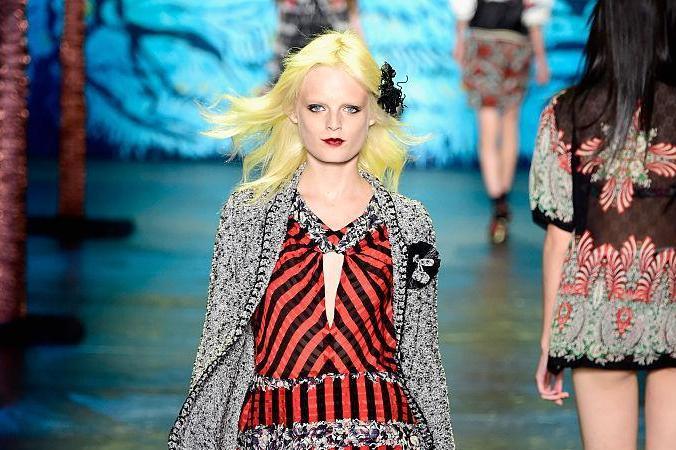Hanne Gaby Odiele: Top intersex model on how doctors tried to change her gender as a child
"I feel like something has been taken away from me for no reason"

Your support helps us to tell the story
From reproductive rights to climate change to Big Tech, The Independent is on the ground when the story is developing. Whether it's investigating the financials of Elon Musk's pro-Trump PAC or producing our latest documentary, 'The A Word', which shines a light on the American women fighting for reproductive rights, we know how important it is to parse out the facts from the messaging.
At such a critical moment in US history, we need reporters on the ground. Your donation allows us to keep sending journalists to speak to both sides of the story.
The Independent is trusted by Americans across the entire political spectrum. And unlike many other quality news outlets, we choose not to lock Americans out of our reporting and analysis with paywalls. We believe quality journalism should be available to everyone, paid for by those who can afford it.
Your support makes all the difference.29-year-old Belgian model Hanne Gaby Odiele hit the front pages a few months ago with her public announcement that she was intersex.
In her video, she also called for an end to the “traumatising surgeries” that are still forced on intersex children to try and change their gender. And she’s now explained why she decided to make the video and what it was like growing up intersex in a quiet village in Belgium.
“Most people don’t know we exist,” she said.
Odiele was born with androgen insensitivity syndrome, which means she is genetically male (so has XY chromosomes), neither uterus nor ovaries, and internal testes.
However her body is resistant to male hormones and she appeared like any other baby girl - her parents thought they had a daughter.
Like many intersex children, Odiele was forced to undergo an operation to make her female (intersex children are usually made female because it’s easier to remove than to add body parts).
“They did more tests and they’re like, ‘Oh, don’t worry, we can just change [her] by surgery, she’ll never even know. It’s all going to be OK,’ ” Odiele told The Times.
“But it’s, like, those surgeries were never explained to me. They didn’t tell the full story, like the harm that could happen. They always said I was the only one, which is not the truth.”
In fact, in her video announcement, Odiele says nearly two per cent of the world’s population are intersex, which is the same as the number of redheads.
As a child, Odiele and her parents told no one she was intersex - not her friends, grandparents or even older brother knew the truth. It was kept secret. She was, in her own words, a “very timid and shy” child.
Aged nine, doctors told Odiele she needed to have her internal testes removed or else they might become cancerous, a claim she now believes is a lie.

“There was no medical evidence that I was going to get cancer,” she says. “Women don’t get their breasts taken out because they might get breast cancer... A normal cis male doesn’t get their testicles cut off either, because they might get prostate cancer or whatever.”
Every few months, Odiele paid a visit to the doctor for “scary treatments”: “I’d go into a room and then my parents were kindly asked to leave. Then all of a sudden four more students come into the room and they all look at my genitals, and they put a blanket over my eyes.
“I feel them touch me and look at me and call me by numbers, like, ‘This is subject blah blah blah.’ They always said I had a bladder problem, and I was like, ‘Mmm, there’s something more.’ ”
Then she had the operation.
“They take away my testicles and from that moment on, it’s kind of like I’m in menopause,” she says. “Since then, I’ve been on hormone replacement therapy, which is messed up.”
The reason she needs HRT is because her internal testes were producing testosterone, but her body rejects it. “So my testosterone is automatically transformed to oestrogen,” she says.
At 18 - after she’d started modelling - Hanne underwent an operation for vaginal reconstruction, which she says can have “extreme” consequences: “Like they cut away sensitive parts that may lead to my having no feeling after… Sex becomes very difficult, even the idea in your mind. Also, incontinency - no bladder control.”
Odiele has now modeled for top designers including Chanel, Prada and Balenciaga, and she’s using her high-profile position to raise awareness about the arbitrary operations intersex children are often subjected to.
“I know people, intersex people, with the same condition as me who didn’t have the surgery, and they live happy, healthy lives,” she says.
Even if they struggle psychologically with being intersex, Odiele believes people who don’t have the operations have fewer psychological traumas because of the surgeries: “They still feel more complete. I feel like something has been taken away from me for no reason.”
Last summer, Odiele married her boyfriend, John Swiatek, also a model, in a field in upstate New York.
“My identity is female and the energy that I carry myself is mostly female,” she says. “Energy. That’s how I think I see gender. As, like, an energy level almost.
“But again, it’s like, I will never know how it is to bear a child, never know how to have a period or to talk about many of the things that females think, or think is important to them. I’m like, ‘I don’t really get that,’ but then I don’t pee standing up either. Like, I’ve never wanted to be a man.
“It’s like, I’m very happy and comfortable being the sex I am and not wanting to change it for anything, actually, in the world, especially now that I live my truth. The past three months, it’s like the most amazing thing that I’ve done for myself actually.”
Join our commenting forum
Join thought-provoking conversations, follow other Independent readers and see their replies
Comments